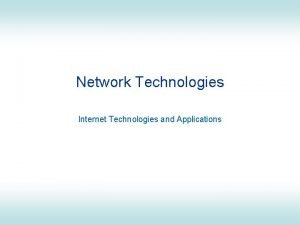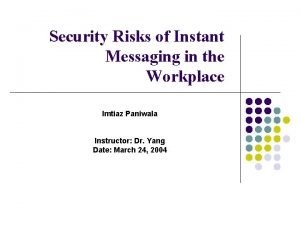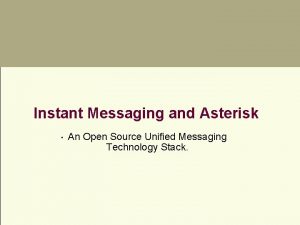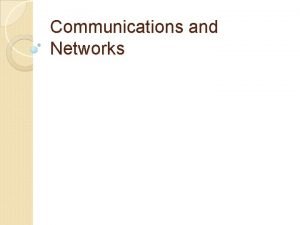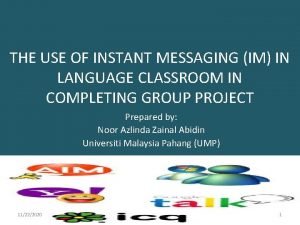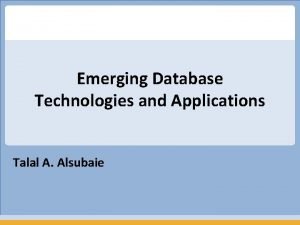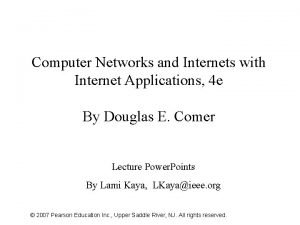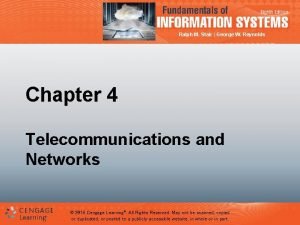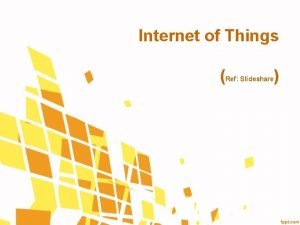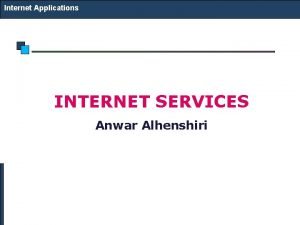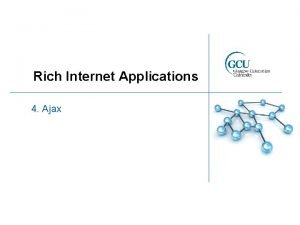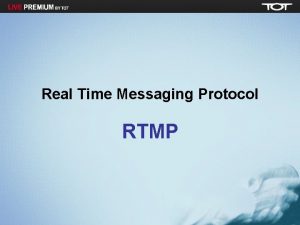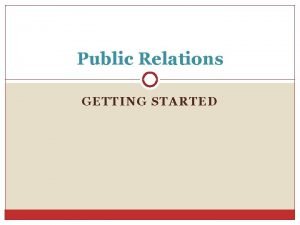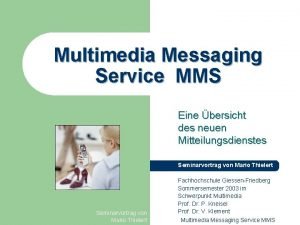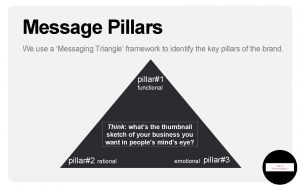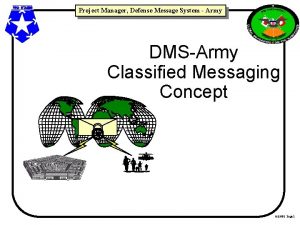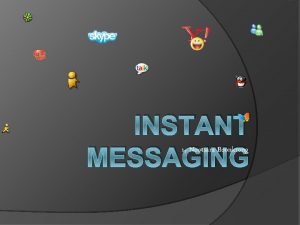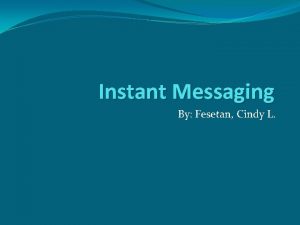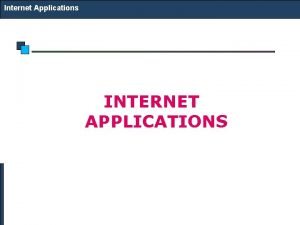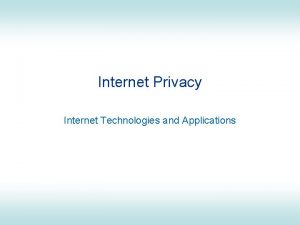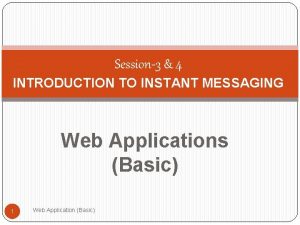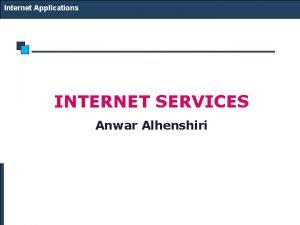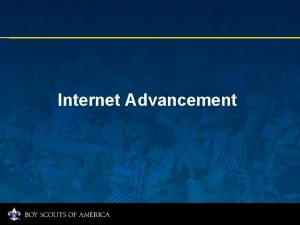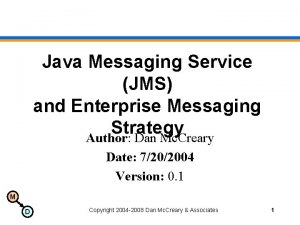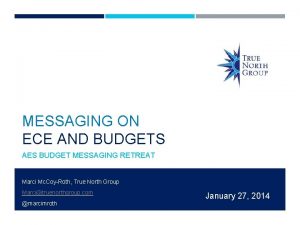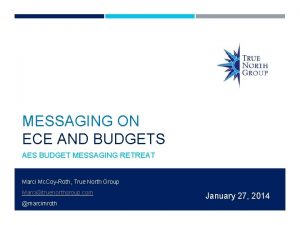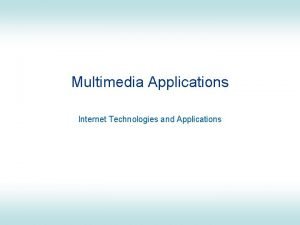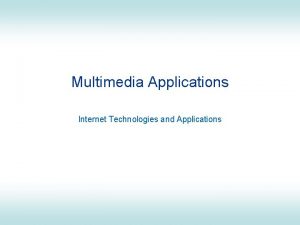Instant Messaging Internet Technologies and Applications Contents Instant
























- Slides: 24

Instant Messaging Internet Technologies and Applications

Contents • Instant Messaging and Presence • Comparing popular IM systems – Microsoft MSN – AOL Instant Messenger – Yahoo! Messenger • Jabber, XMPP and Google Talk ITS 413 - Instant Messaging 2

Internet Messaging • Email – Asynchronous communication: user does not have to be online for message to be delivered (not instant messaging) • • Newsgroups Instant Messaging and Presence – UNIX included finger and talk • Finger: determine the presence (or status) of other users • Talk: text based instant chatting application – Internet Relay Chat (IRC) • Introduced in 1988 as group based, instant chatting service • Users join a chat room • Networks consist of servers connected together, and clients connect via a single server – ICQ (“I Seek You”) • Introduced in 1996, allowing chatting between users without joining chat room • In 1998 America Online (AOL) acquired ICQ and became most popular instant messaging application/network – AIM, Microsoft MSN, Yahoo! Messenger, Jabber, … • Initially, Microsoft and Yahoo! Created clients to connect with AIM servers • But restricted by AOL, and most IM networks were limited to specific clients • Only recently (1 -2 years) have some IM networks opened to different clients ITS 413 - Instant Messaging 3

Instant Messaging and Presence • Instant Messaging – Synchronous communications: message is only sent to destination if recipient is willing to receive it at time it is sent • Presence – Provides information about the current status/presence of a user to other users – Other users can subscribe to the presence information of a particular user – E. g. : Online, Busy, Away, Offline – Controls what messaging options are available (cannot send message when someone is offline) • Naming – Most systems use email address format for naming ITS 413 - Instant Messaging 4

Popular IM Applications/Networks • Closed – use proprietary protocols, normally limiting only their own clients to access network – AOL Instant Messaging (AIM) – Microsoft Messenger (MSN) • Also known as Windows Messenger, Live Messenger – Yahoo! Messenger (YMSG) • Open – use open (published) protocols, normally allowing any client to access network – Jabber and XMPP ITS 413 - Instant Messaging 5

Comparing AIM, MSN and YMSG

Client/Server Architecture • A client/server architecture is main mode of operation for AIM, MSN and YMSG – Provider (e. g. AOL, MS, Yahoo) host servers for network – Clients connect to servers to establish sessions and exchange messages – How to make system scale with number of users? • Symmetric servers (YMSG) – Each server performs identical (and all) functions, but they are replicated – Users will log in to one of the servers based on random selection, geographical/network proximity, load, etc. • Asymmetric servers (MSN, AIM) – Each server is dedicated to a particular activity such as log on, basic messaging, chat room, presence, … – Users contact the necessary server – Log in server uses well known port/address to connect to – Advantage of Client/Server architecture: providers can easily control what users do; easier for clients to access services via firewalls – Disadvantage of Client/Server architecture: scaling service as number of users increases is difficult – as a result, several services are offered in P 2 P mode (e. g. voice-chat sessions) • MSN and AIM use P 2 P for voice chat; however it is much harder to do group -based voice communications using this model 7

Features and Functions • Maintaining lists of friends (and enemies) – Buddy list: users who are considered friends; notified of presence of these users – Block list: users who cannot contact you – Allow list: users that can contact you – Reverse forward lists: users that have you on their allow list – All lists are maintained on provider servers; synchronised when a user logs in • Messages to describe user’s current typing activity: – E. g. typing, not typing, typed but erased • Deliver messages to users that are not online (similar approach to how email works) • Secure communications (at least offered by AIM) – SSL used to secure messages and chat rooms ITS 413 - Instant Messaging 8

AIM System Architecture ITS 413 - Instant Messaging 9

MSN System Architecture ITS 413 - Instant Messaging 10

Yahoo! System Architecture ITS 413 - Instant Messaging 11

Session Distribution • How do systems distribute functionality/session across multiple servers? • AIM – Login to main authentication service, which directs client to BOS server – BOS = Basic OSCAR Service; OSCAR is a basic messaging protocol, originally develop in ICQ – TCP connection with BOS server is established, and this is main connection for exchanging information with provider, as well as text instant messages • BOS server provides addresses of other services, and client connects them on demand • To access chat room, client finds address of chat room setup server; chat room setup server sends verification that client can access a chat room to BOS server; then BOS server directs client to a specific chat room server • Yahoo! – A single TCP connection is used to handle all control messages, instant messages and chat sessions ITS 413 - Instant Messaging 12

Session Distribution • MSN 1. Client initially contacts dispatch server (which has well-known address/port) 2. Client directed to notification server and establishes a permanent TCP connection • Used for main control messages, including presence notifications 3. Authentication is performed with MSN passport servers (described shortly) 4. All IM and chat sessions are via switchboard servers – – IM and chat are treated the same (IM is just chat between 2 people) Also handles requests for file transfer, voice/video sessions (which are then established peer-to-peer between clients) ITS 413 - Instant Messaging 13

User Authentication • User and provider have a shared secret: user’s password • Login authentication performed using HTTP over TLS – A hash of password is sent (so others cannot see password) • Although username is sent in clear • Weaknesses in some hash algorithms may allow a dictionary attack on the password – Avoids using expensive (in computation) public key encryption operations • MSN and AIM send cookies (in clear) to client as credentials – Possible for attacker to intercept cookie and then impersonate the client ITS 413 - Instant Messaging 14

Data Transfer • Message formats – AIM and YMSG use binary formats, which are more efficient than text formats AIM • AIM uses variable length headers, which can be efficient • YMSG uses fixed length headers, which are easier to parse and process YMSG – MSN uses text format, which is easier to understand debug (for humans) MSN 15

Data Transfer • Excessive message rates – With centralised servers, an IM network could easily be flooded if users send IMs at high rates – TCP provides congestion control in Internet, but IM providers also need to protect servers against denial-of-service attacks – AIM provides rate control on different message times • If number of messages over a period of time exceeds threshold, users’ are warned, and may be disconnected – YMSG has a static limit of messages per second (e. g. 3) • Controlled by client provided by Yahoo! Therefore other clients may not implement this rate control • Session lifetimes – When client is inactive, need to end session (TCP connections) as they consume memory and CPU resources – All systems use a heartbeat – periodic messages to keep session alive • AIM: client sends heartbeat every minute • YMSG: server sends request to client every X minutes, client must respond • MSN: client heartbeat and server heartbeat (client must respond) ITS 413 - Instant Messaging 16

Jabber and XMPP

Jabber and XMPP • Jabber was an open source IM application (and protocol) developed in 1998 • Separately IETF provided a general framework for IM in the Instant Messaging and Presence (IM&P) model (RFC 2778) – Jabber was standardised as Extensible Messaging and Presence Protocol (XMPP) by IETF (RFC 3921) – The IETF also had a separate Working Group that developed SIMPLE, an alternative IM protocol using Session Initiation Protocol (SIP) (RFC 3428) – XMPP is now extended by XMPP Standards Foundation • XMPP is used by: – Google Talk; Gizmo; supported by Gaim; many Jabber clients and servers ITS 413 - Instant Messaging 18

Generic IETF IM&P Model ITS 413 - Instant Messaging 19

Jabber Architecture ITS 413 - Instant Messaging 20

Jabber Architecture • Client/Server architecture is used in Jabber – Although not centralised – can be many servers, and hence messages must be forwarded between servers • Clients connect to servers using TCP – XMPP is used to exchange information between client and server • Server: – – Resolver determines where to send a message Router routes/forwards the message based on info from resolver Servers exchange information with other servers using XMPP Stores clients information and contact lists • Gateway may be implemented to connect to other IM systems, e. g. SIP/SIMPLE, MSN, AIM, … ITS 413 - Instant Messaging 21

XMPP • Protocol based on XML messages – Three defined XML message types: • Message – carries IMs between clients and servers – chat, error, groupchat, headline, normal • Presence – used to notify client about status of users – unavailable, subscribed, unsubscribed, probe, error • IQ (info/query) – request/response queries to exchange other information between clients and servers (e. g. setting up a session) ITS 413 - Instant Messaging 22

XMPP/Jabber Example Messages • Client to server: • Server response: <? xml version="1. 0"? > <stream: stream xmlns: stream=http: //etherx. jabber. org/streams xmlns="jabber: client" to="example. org"> <stream: stream xmlns='jabber: client‘ xmlns: stream='http: //etherx. jabber. org/streams' from='example. org' id='1461777714'> • Client login (unsecure; there is a secure option): • Server result: <iq type="set" id="auth_2" to="example. org" > <query xmlns="jabber: iq: auth"> <username>alice</username> <password>password</password> <resource>Work</resource> </query> </iq> <iq from="example. org" id='auth_2' type='result'/> ITS 413 - Instant Messaging 23

XMPP/Jabber Example Messages • Client message: • • The message is then sent to Bob (either his server or client) Server response to client: <message to="bob@example. com" > <subject>Hello!</subject> <body>Can't wait to see you tomorrow. </body> </message> <presence type="unavailable" > <status>Logged out</status> </presence> </stream: stream> ITS 413 - Instant Messaging 24
 Aim lans
Aim lans Instant messaging security risks
Instant messaging security risks Asterisk instant messaging
Asterisk instant messaging Wireless instant messaging
Wireless instant messaging What are the uses of im language
What are the uses of im language Emerging database technologies and applications
Emerging database technologies and applications Emerging database
Emerging database Computer networks and internets with internet applications
Computer networks and internets with internet applications Extensible messaging and presence protocol
Extensible messaging and presence protocol Applications of internet
Applications of internet Slideshare io
Slideshare io Applications of internet
Applications of internet Applications of internet
Applications of internet Rich internet applications with ajax
Rich internet applications with ajax Internet or internet
Internet or internet Realtime messaging protocol
Realtime messaging protocol Bidirectional patient messaging
Bidirectional patient messaging Pr message
Pr message Cisco unity connection unified messaging office 365
Cisco unity connection unified messaging office 365 Multimedia messaging service center
Multimedia messaging service center Messaging pillars
Messaging pillars Implicit messages are
Implicit messages are Campaign message example
Campaign message example Defense message system
Defense message system Personalized statement messaging
Personalized statement messaging
